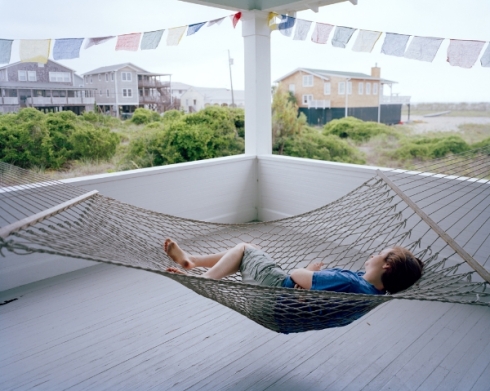You are currently browsing the category archive for the ‘Photojournalism’ category.

How can images tell the story of mass incarceration when the imprisoned don’t have control over their own representation? This is the question Dr. Nicole R. Fleetwood asks as editor of the latest Aperture (Spring 2018).
“Prison Nation” can be ordered online today and hits the news-stands next week. Devoted to prison imagery and discussion of mass incarceration, the issue presents a slew of works across contrasting genres — landmark documentary by Bruce Jackson, Joseph Rodriguez and Keith Calhoun & Chandra McCormick; luscious and uncanny portraits by Jack Lueders-Booth, Deborah Luster and Jamel Shabazz; insider images from Nigel Poor, Lorenzo Steele, Jr. and Jesse Krimes; and contemporary works by Sable Elyse Smith, Emily Kinni, Zora Murff, Lucas Foglia and Stephen Tourlentes.
Equally exciting is the banger roster of thinkers contributing essays, intros and conversations — including Mabel O. Wilson, Shawn Michelle Smith, Christie Thompson, Jordan Kisner, Zachary Lazar, Rebecca Bengal, Brian Wallis, Jessica Lynne, Reginald Dwayne Betts, Ruby Tapia, Zarinah Shabazz, Brian Stevenson, Sarah Lewis, Hank Willis Thomas and Virginia Grise.
I have an essay ‘Prison Index’ included which looks back on almost a decade of this Prison Photography website–how it began, what it has done and what it has become. I highlight a dozen-or-so photographers’ works that are not represented by features in the issue itself. I wonder how PP functions as an archive and what role it serves for public memory and knowledge.
MATCHING QUALITY CONTENT WITH QUALITY DESIGN
I’ve known for years that Prison Photography requires a design overhaul. This past week, I’ve moved forward with plans for that. It goes without saying that the almost-daily blogging routine of 2008 with which Prison Photography began has morphed into a slower publishing schedule. There’s a plethora of great material on this website but a lot of it is buried in the blog-scroll format. My intention is to redesign PP as more of an “occasionally-updated archive” whereby the insightful interviews from years past are drawn up to the surface.
It’s time to make this *database* of research more legible and searchable. Clearly, as this Aperture issue demonstrates, the niche genre of prison photographs is vast and it demands a more user-friendly interface for this website. I’m proud to be included in “Prison Nation” but know it’s a timely prod to develop Prison Photography’s design and serve the still-crucial discussions.





Get your copy of Aperture, Issue 230 “Prison Nation” here.
Thanks to the staff at Aperture, especially Brendan Wattenberg and Michael Famighetti for ushering and editing the piece through.
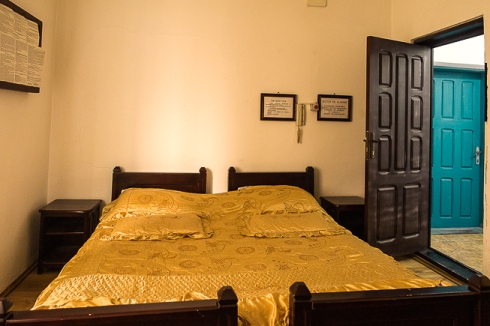
In modernizing institutions, new laws to permit intimate partner visits for prisoners were established. Cosmin Bumbuţ visited every penitentiary in Romania and photographed the boudoirs.
We’re obsessed with sex as much as we’re shy to talk about it open and honestly. We’re fascinated by prisons, particularly fictionalized accounts of prisons (Oz, Animal Factory, Shawshank, Orange Is The New Black, The Green Mile, the list goes on-and-on) but often our fascination doesn’t extend far enough to talk openly about what our prisons actually are and how they’re a symptom of a divided, racist, unforgiving social order. We’ve still a lot to unpack around prisons. Around sex too, we’re picky about what and where we unpack. I say this to acknowledge the fact that this is an article about sex, and prisons, and sex in prisons and those are fiery catalysts to the imagination. Be honest, you’re here because of the headline and you’re wondering whether to read these 1,300 words or just scroll through the pictures.
Fortunately, for us, these pictures, made by Romanian photographer Cosmin Bumbuţ (who is also one half of Teleleu.eu), sate our outsider curiosity without dragging us into a debased voyeuristic quagmire.
The series, titled Camera Intima, is expertly shot with phenomenal manipulation of space and lenses to secure these angles. Despite some of these rooms being converted basement store-rooms, the photos are well-lit and flooding with joyous color and pattern. Perhaps you enter this photo essay — and these rooms — expecting cheap gags, but you exit with a rounded and informed perspective on a type of room designed to meet 21st century policy, to ensure dignity and to bolster family relationships.
“In 2007, Romania joined the European Union,” explains Bumbuţ. “The whole prison system went through major revamp and the biggest reform was to introduce the right to private visits.”
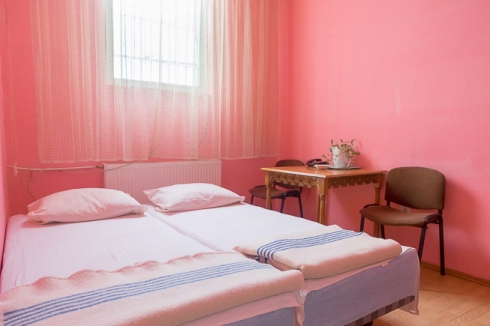



Simply put, the price for entry into Europe’s *modern* club was to allow previously-forgotten and despised convicts to get it on with their loved ones. Married prisoners and those in long term relationships have the right to one 2-hour private visit, every three months.
“Plus, if a prisoner gets married in detention he or she can spend 48 hours with the spouse in the special room and is allowed visits once a month in the first year of marriage,” explains Bumbuţ.
It’s obvious to say that these conjugal visit rooms are for sex. But it’s worth noting they are intended only for sex. In the United States, by comparison, conjugal visit trailers and designated rooms are set aside for the whole family. In these Romanian rooms, the only visitors are intimate partners but in the United States the purpose of family visits is broadened beyond just sex. Prisoners spend time with their children, siblings and parents; trailer visits are meant to strengthen family bonds throughout the entire clan. As such, US trailers have kitchens, dining and common areas.
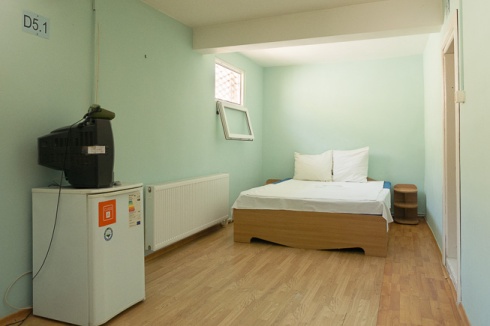
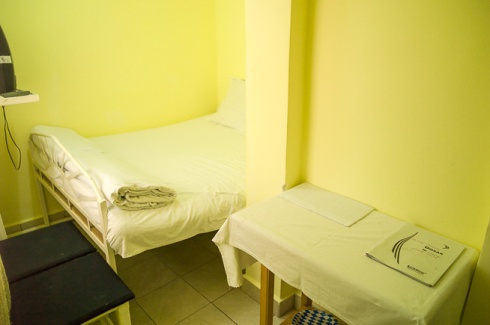


In Bumbuţ’s photos we see mostly, just the beds. For all their undeniably functional design for the carnal, these rooms are rather underwhelming. At its root, this photo essay could be of cheap motel rooms; they share the same essential elements — TV, mini-fridge, the occasional soft furnishing, nasty carpet and a sign or two reminding occupants of rules. The picture that these are prison rooms is Bumbuţ’s image of the cover page of the ‘Intimate Room’ handbook.

Between 2013 and 2014, Bumbuţ photographed the “private rooms” in all 40 Romanian penitentiaries. “I think I can boast of being the only civilian who entered all the Romanian prisons,” he says.
It wasn’t a project that came out of the blue. Back in 2009, he facilitated a photo workshop for women prisoners in Târgșor Penitentiary (more about that here). Soon after that he embarked on a multiyear project documenting life in the notorious Aiud Penitentiary. He witnessed a creaking and unsanitary lock-up trying to clean up and drag itself into the 21st century.
“In 2005, Aiud looked like a prison from the Communist era. Rooms were dirty and the walls unpainted, the cells were very small and crowded,” says Bumbuţ. “In 2008, it was renovated and the cells were expanded, the prisoners didn’t wear uniforms and were referred to as ‘Persons deprived of liberty’! Romanian prisons started to look like the ones from the American movies, with white walls and new metal shiny doors.”


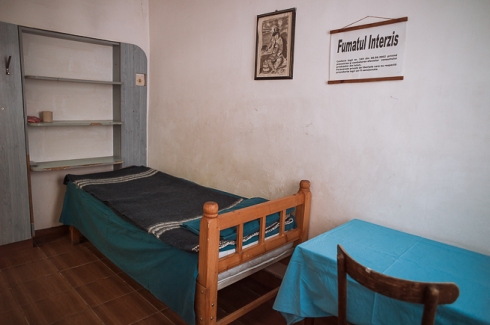
Even though prisoners are still handcuffed, Bumbut has, since 2008, been prohibited from photographing cuffed prisoners. Now it’s about image as much as it is about policy. When Bumbuţ first made his request to the National Prison Administration to photograph the conjugal visit rooms, he received quick approval and thanks for his dedication and help to the prison administration programs. Bumbuţ became well practiced at working in prisons. He reduced his equipment to a camera, a lens, a spare SD card and a spare battery to get through security checks as quick as was possible (often not quick at all).
The photographer’s good-standing all changed upon the release of his book Bumbata, an anthology of his best photographs from four years of shooting in Aiud Penitentiary. (Bumbuţ and I had an extended conversation about Bumbata in 2013).
The book was considered to gritty and perhaps, even, too sympathetic to the prisoners. Either way, it was seen as a damaging depiction. From there-on out, Bumbuţ was light on his feet and diplomatic. His access was never withdrawn.
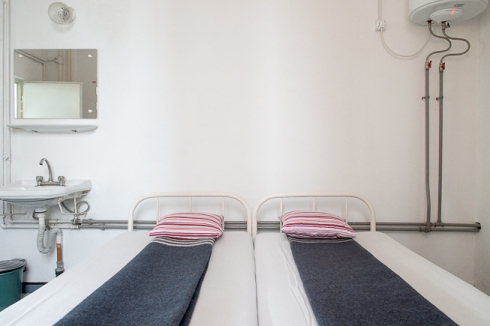


The pregnant pause within these rooms is what gives Camera Intima strength as an body of work. We look at the photographs and they ignite our imaginations about what goes on inside. When the door is open — and we and the photographer peer in — there’s nothing to see. What goes on behind closed doors will never be photographed. This tension is characteristic of good photographic series that insert themselves into the relationships of public/private space and personal/institutional power.
“Prisoners are allowed officially to have sex inside an institution, but they have to follow all the bureaucratic steps,” explains Bumbuţ, “to write a request, to wait for the approval, to obey the rules.”
Guards and the administration hold the promise of access to the rooms as a carrot to motivate prisoners toward good behavior.
“Only prisoners who behave in prison are allowed to have private visits,” says Bumbuţ. “Prisoners are more obedient when they have access to the intimate rooms.”
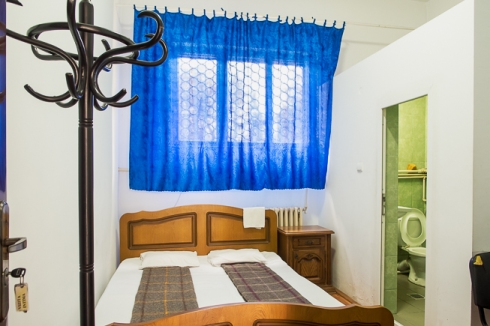


Similarly, in the U.S., conjugal visits are seen as a very effective way to maintain prisoners’ complicity, even docility. Not all U.S. prisoners enjoy regular time with their family or intimate partners. All conjugal visits are banned within the Federal system and while states are left to rule on their own prison policies, only four — California, Connecticut, New York and Washington — currently allow trailer visits. In 2014, both Mississippi and New Mexico summarily ended their conjugal visit programs.
Sometimes these decisions will be couched in language about security but more often than not the decision rests upon public opinion (outrage), the moral judgements of the administration in power and probably the bottom line. It’s cheaper to keep men and women locked in boxes than it is to provide programming.



Back in Romania, it doesn’t matter what system or prison you’re in, your right to have conjugal visits is protected by law. And Bumbuţ was in many prisons when these visits took place. For a while he toyed with the idea of making portraits of prisoners and visitors.
“I even shot a couple before and after their private visit,” says Bumbuţ. “But when I looked at the portrait, I realised that it became too much about the couple and not about the intimate room.”
Bumbuţ wanted to spark our curiosity. He wanted to focus on the space and all the emotions, release, frustrations, love and contained freedom they embody.
Even though these rooms allow two humans to come together, they’re not places about individuals or individuality. They’re function spaces for the continuance of criminal justice policy. We know that given the choice, no-one would want to opt for these converted cells, cramped quarters or side-thought accommodations for their sexy time. No, Bumbuţ’s photographs are all about the denial of comfort and personal circumstance. These are compromise spaces. They’re about making do as much as they are about making out and they reveal carceral logic itself.
“So I decided to shoot the empty rooms.”

If you’re still with my these 1,300 words later, I’m glad you stayed the course and I hope I’ve convinced you that these images are more than visual one-liners. That, in fact, by photographing in every Romanian prison — 40 in total — Bumbuţ has created a unique, complete and priceless sociological survey. These four walls are the fulcrum between Romanian rule-of-law and the European Union compact; they’re the pivot of negotiation between prison and prisoner; and, of course, they’re containers for sexual expression between prisoners and loved ones. Ultimately, the rooms are the physical manifestation of contradiction.
“These are spaces for intimacy,” concludes Bumbuţ. “But, at the same time, the prison itself denies almost all desperately needed intimacy.”
In recent years, Cosmin Bumbuț and journalist Elena Stancu have traveled through Romania in an RV telling stories about today Romania, marginal communities and extraordinary people. They are Teleleu.eu. Follow Bumbuț and Stancu at the Teleleu.eu website and on Facebook, Twitter and Instagram.
A boy from Afghanistan tries to keep warm after a cold and wet crossing from Turkey. Cases of hypothermia are on the increase as the weather deteriorates across the eastern Mediterranean.
In an image saturated world it’s difficult to define and measure the effects of photographs. We know advertising works, but those are images intended to sell us stuff. What if the purpose of a photograph is to “sell” us of a moral or political point? What if a photograph wants us to shift our emotional and practical response to far away events?
Giles Duley’s work Lesvos: Crossing To Safety made in Greece last October are intended, firstly, to bear witness and, secondly, to provoke action to help the hundreds of thousands of migrants. That’s why he didn’t simply make images and send them to the wires, but he courted the support of the United Nations so that he might extend the distribution of his images — and the refugees’ stories — far into global, humanitarian dialogue channels. (This UN-produced feature on Duley’s career and motivations is very thorough.)
Not content with only traditional distribution channels, Duley looked for alternative ways of launching his images into an unorthodox space; a Massive Attack gig.
“The scenes were overwhelming,” Duley said to the UNHCR. “In all the time I’ve worked, I’ve never seen such emotion and humanity laid so bare as I witnessed on the beaches of Lesvos. One of the first emails I sent was to the guys in Massive Attack. Seeing such events, I felt so powerless, I needed to do something. At that stage I had no idea how the collaboration would work, but I knew the band would want to act.”


Stills of Giles Duley’s photos on screen behind the stage of Massive Attack. Courtesy: Massive Attack.
A founding element of the era-defining Trip Hop genre, Massive Attack are known for taking forthright stances on political and governmental behaviours. Saturday Come Slow, their collaboration with released British Guantanamo detainees, Broomberg & Chanarin and Damon Albarn was poignant, crafted and clever, I thought.
Furthermore, as Alexis Petridis wrote for the Guardian, “Massive Attack have worked with the Stop the War coalition and visited refugee camps in Lebanon, while in 2011, Del Naja and Radiohead’s Thom Yorke threw a party for Occupy protesters who had taken over a UBS bank building in London.”
It’s not surprise Massive Attack are lending their support to Duley and shocking their euphoric crowds with thumping reality. Duley’s images loop throughout the gig, but they get their biggest showing at the close of the show, when the music ends and the band leaves the stage. For minutes — in silence — the crowd is shown a mammoth slideshow of Syrians and other migrants landing in boats, hungry, tired and terrified. A far cry from the revelry of a gig. But people stayed. This Channel 4News segment is well worth the watch:
History has taught us that photos can certainly alter the mood of entire populations. Practice has also taught us that earnest, targeted messaging can help photos land. I hope more artists can lend a hand to serve the messages of humanitarian photographers. Usually, professionals commission images to be made to meet their own messaging needs so it’s great to see artists, citizens and successful public figures provide space within their platforms to amplify photographer’s voice.
Included here are Giles Duley’s images from Lesvos, Greece, made in October 2015.

An overcrowded boat carrying Syrian refugees heads to shore. One Syrian man had fallen from the boat into cold water. He was later rescued by volunteer Spanish lifeguards. Despite the approach of winter and worsening weather, refugees are continuing to arrive on the island at a rate of more than 3,200 per day. As of mid-November, at least 64 people have drowned this year in 11 shipwrecks off Lesvos.

Boat after boat lands on the coast of Lesvos between Eftalou and Skala Sykaminia. Over 45 per cent of the 836,088 refugees and migrants who have arrived in Europe so far in 2015 have landed on this Greek island, which is separated from Turkey by a 10-kilometre channel.

An Afghan mother holds her child moments after landing on the beach near Skala Sykaminia. UNHCR and its partners work to prevent family separations and create safe areas for women and children who are particularly vulnerable.

An Afghan family of several generations disembark from an overcrowded boat. Almost 40 per cent of refugees currently arriving on Lesvos are from Afghanistan.
–
UNHCR is working around the clock with other agencies and aid groups, stockpiling and distributing winter aid items to keep vulnerable people, both in camps and urban settings, protected and warm. Donate money to the UNCHR (United Nations High Commission for Refugees) here.
• The distribution of winter survival kits including high thermal blankets, sleeping bags, winter clothes, heating stoves, and gas supplies.
• The provision of emergency shelters including family tents, refugee housing units and emergency reception facilities.
• Improvement of reception and transit centers and preparing and supporting families for winter conditions.
You can help make a difference. Donate money to the UNCHR (United Nations High Commission for Refugees) here.
–

A relieved Afghan family, clearly still suffering from the trauma of a rough sea crossing at the hands of people smugglers, disembarks from a flimsy vessel onto a Lesvos beach.

An Afghan mother hugs her child and cries with relief after arriving on Lesvos.

Survivors struggle ashore after their boat has capsized. In the background a Spanish lifeguard, one of the many volunteers working on the beach, swims out to help other survivors.

A Syrian father, his two children now safely wrapped in thermal blankets, looks to the heavens in thanks after landing safely on the beach.

A young Afghan boy with his aunt. His mother is receiving emergency medical treatment after she collapsed upon landing. Since August UNHCR, in close cooperation with the Greek authorities and other humanitarian actors, has considerably stepped up its activities to respond to the increasing needs. This is even more imperative with the onset of winter.

Volunteers prepare to wrap a young girl in an emergency blanket to protect her from the cold wind.
–
Follow UNHCR on Instagram, Twitter and Facebook. Donate money to the UNCHR (United Nations High Commission for Refugees) here.
Read ‘War Survivor Focuses Lens on Refugees‘ about Duley’s work in Greece. Reacquaint yourself with the ‘Lesvos: Crossing to Safety‘ feature. Read a review ‘How Many Stories Can You Tell In One Second?‘ of Duley’s new book One Second of Light.
Connect with Giles Duley on Facebook, Twitter, Linked In and EW Agency.

Sean O’Hagan writes:
Lyon was a pioneer of what might be called immersive photojournalism, steeping himself in his subject matter in the manner of pioneering 60s writers of the New Journalism school such as Tom Wolfe and Hunter S Thompson. He builds the visual narrative around extended personal accounts by selected inmates, the often intimate descriptions of life inside illuminating his already powerful images. “The text of the book, compiled from prison records and convict writings, presents the lives of a few of these men,” he writes in his introduction. “They are the heroes of this book. I knew each of them as well as a free man can.”
[…] On every level, then, Danny Lyon’s approach flies in the face of detached documentary reporting, but it is this that also makes his work so viscerally forceful.
Read the full piece: Conversations With the Dead: Book review – 60s prison life in the US

Reporting on the prison industrial complex requires many tactics of approach in order to sustain audiences’ attentions and emotions. For all the constant misery, shame and violence the prison systems of America mete out, that relentless mood of defeat cannot dominate the flow of reported stories. Prisons are scary enough without giving people added fatigue and an easy option to turn away from stories heated the same beat-down drum. I guess this applies to all serious issues and is why human interest stories exist in journalism.
Human interest stories are great, but they have their place. Within the prison system are human interest stories ones that journalist find or are they ones fed to them? We’re headed into the weekend here and the sun is up so I don’t want to be a debbie-downer but I want to flag this contested context before celebrating Grant Blankenship’s latest human interest story, Say a Prayer for the Barber.

Anthony Ponder spent many years in prison in Georgia. He was released on August 18th. Not knowing where to go he spent his first night out asleep in the truck outside his uncle’s house. While he was inside he was the prison barber.
“Population barber. So I’ve got plenty of practice. Unfortunately.”
Anthony wasn’t afforded much help when he got out form the state. But two churches in the town of Macon, GA did; Centenary Church and Vineville United Methodist Church gave him clippers, scissors and a chair and a space to cut hair. Every Sunday morning, Anthony cut the hair of men.
Every Sunday morning, Anthony cut the hair of men who are making the transition, as he did, from prison or jail back into society.
“I was attracted to the story because of its simple reciprocity. A man is given a hand up and he returns the favor,” says Blankenship. “I was not assigned the story, but when I heard about Anthony I jumped on it pretty quickly.”
The full piece, including audio is titled Say a Prayer for the Barber. Recommended.
Anthony’s “shop” is located in Centenary Church which works with a number of men, providing transitional housing and other services. Eric, an organizer at Centenary, asked Anthony if he would like to volunteer but Anthony couldn’t imagine how to without the gear he had had before his incarceration.
“So Mr. Eric, we had a conversation he said he had a way that he could buy all the tools for me if I worked so many times cutting hair he would donate them to me,” recounts Anthony in Blankenship’s story.


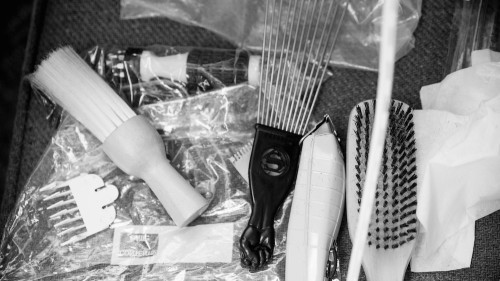
Blankenship a staff audio and visual reporter for Georgia Public Broadcasting is at the forefront of highlighting, through images, the issues of incarceration to Georgians.
“Public policy regarding former prisoners is shifting,” says Blankenship, who stresses he no expert on prison issues. “For example, my community of Bibb County, GA recently adopted a ban questions on job applications about felon status in an attempt to make hiring practices more immediately meritocratic.”
At the state level, new programs are slowly being introduced to aid returning citizens’ reintegration into communities and the wider economy. I’ve heard anecdotally, from photographers who’ve worked in Georgia’s prisons, that they’re below par, threatening and without significant programs. Georgia’s prisons are overcrowded. Reentry efforts will have to be redoubled to scale back on the damage done by an out of control system.
“Time will tell how those efforts pan out,” says Blankenship of reentry projects.
The state is making moves toward accountability.
“Though it has yet to be tested, a bill passed this year is touted as making the parole process, and even the granting or denial of clemency for death row inmates, more transparent,” says Blankenship who reported on the vague language of a new death penalty pardons bill here and here. “We are in the midst of a subtle but perceptible cultural shift. That’s the eight mile high view.”


In the mean time, we can hope for the best for Anthony and other men and women rejoining society after long stints away. Thanks to some imaginative thinking on the part of some church leaders, Anthony can connect with others in one of their most difficult moments.
“I want to give him some hope. Like I have. That’s my aim. Give him hope. Let him know there is hope. There’s a better way. If he’s down and depressed and discouraged, let him know there’s a better way.”
It’s an uplifting story, but returning to me opening caution. We must remember that people make it out of prison and stay out in spite of the system not because of it. As heartwarming as Anthony’s story is and as easy it is to connect with his warmth and generosity, we must not be distracted from seeing the larger systemic inequalities at play that.
That said, Blankenship’s cracking images and Anthony Ponder’s words of wisdom are the hook by which we are all snagged. And here we are talking about Georgia’s prisons.
The story was only positive for Blankenship. A joy to work on.
“I am grateful to Anthony for sharing so much with me for no good reason,” says Blankenship. “I’m left wanting the absolute best for him. He’s a kind man.

Read and listen to Blankenship’s full report Say a Prayer for the Barber.

Heidi Levine hugs her driver Ashraf Al Masri after his home in Gaza was destroyed. Photo: AP/Lefteris Pitarakis
It can be tricky to talk about photojournalists’ work without over-simplifying, romanticising or glorifying. Thankfully, this piece Bearing Witness does none. Writer Doug Bierend does a sterling job of describing the decade-long work of Heidi Levine and teasing out the bittersweet award of the inaugural Anja Niedringhaus Courage in Photojournalism Award for her coverage of the Israeli bombardment of Gaza in the summer of 2014. Levine knew Niedringhaus and an award is a strange thing in the face of societies destroyed by war:
“This award has made me reflect, and spend a lot of time thinking back and understanding — I have been very lucky. We were talking about experience — sometimes it’s not even how experienced you are, it can boil down to just having bad luck. I guess I’ve always felt committed to bearing witness, and feel that is just so important to give people the opportunity to know what’s happening in the world, and I don’t believe that there’s any excuse anymore for people looking the other way and claiming, as they did in the past, in history, that they were just unaware and didn’t know.”

Wounded Palestinian Rawya abu Jom’a, 17 years old, lays in a hospital bed at the Al Shifa Hospital in Gaza City, July 22, 2014. Rawya was seriously injured when two Israeli air strikes hit her family’s apartment. Her sister and three of her cousins were killed in the attack. She is suffering from shrapnel in her face, her legs have perforated holes in them and the bones of her right hand were crushed. Photo credit: Heidi Levine/The National/Sipa Press
Keith Axline and I are editors of Vantage — a new gorgeous place for looking and photos and learning their context.
Some photos we feature are gorgeous and some are gory. In Levine’s case she manages to combine to the two. As Bierend puts it, Levine makes pictures in “a subtle or even artful way requiring a high degree of sensitivity [that] sees through the violence to the dignity of the subjects suffering at its heart. At its best, this skill can convey the true stories of conflict, the hidden personal and private lives shaken to their foundations by the nations, militaries, and leaders which tend to be the sole subjects in any discussions about war.”
It’s a sobering piece. Levine talks about risk, fixers and luck. I’ll leave you with another statement of hers:
“If you’re not trained, it’s really, really important to become trained, to take a hostile environment course, to take a combat medical training class … I have seen a lot of people out there in the field that are very inexperienced. It’s not like rockets or bullets discriminate between who is experienced and who’s not experienced. As you saw, Chris Hondros, who was one of the most experienced conflict photographers, was killed in Libya.”
Read in full at Bearing Witness.

Women mourn during the funeral of the boys killed by an Israeli naval bombardment in the port of Gaza, Gaza City, July 16, 2014. Four boys died instantly during an Israeli naval bombardment in the port of Gaza, a fifth boy died shortly after the attack in hospital. Israel stepped up its attacks on July 16 by bombing the homes of Hamas leaders after the Islamist movement rejected a truce proposal and instead launched dozens more rockets into Israel. Photo: Heidi Levine/The National/Sipa Press

Palestinian men run with a white flag in the Shejaia neighborhood, which was heavily shelled by Israel during the fighting, in Gaza City, July 20, 2014. At least 50 Palestinians were killed on Sunday by Israeli shelling in the Gaza neighborhood, and thousands fled for shelter to a hospital packed with wounded, while bodies were unable to be recovered for hours until a brief cease-fire was implemented. Photo: Heidi Levine/The National/Sipa Press

Palestinians collect religious books in the rubble of the Al-Qassam mosque in Nuseitat camp, located in the middle of the Gaza Strip, July 9, 2014. Photo credit: Heidi Levine/The National/Sipa Press

Hidya Atash stands on the top floor of her home as she overlooks the destruction in Shujayea, at dawn Aug 8, 2014. Her family’s home was hit two weeks prior by a warning rocket and the family of 40 people fled. When they returned during the cease-fire, they discovered their home was heavily damaged during the fighting. Photo credit: Heidi Levine/The National/Sipa Press

A small, unbreakable tin wall mirror in a solitary cell. Reflection is of a slatted window. Photo: Ashley Gilbertson/VII Photo for New York Magazine.
The suicide of Kalief Browder was the latest, most tragic reminder of how much of a hell hole Rikers Island is. It was the combined effects of broken bail and juvenile prison systems that killed Kalief.
Take your pick of the coverage from The Guardian and the New York Times, to New York Magazine. What has been consistent in the coverage of Rikers as information about conditions and treatment is that visuals have been limited and it has relied on the progression of lawsuits and news FOIA requests. Whistleblowers have been few and far between and prisoners’ testimonies are notoriously difficult to verify.

An August 2013 fight in the George R. Vierno Center, caught on surveillance tape.
That makes the recent feature Rikers Island, Population 9,790, a joint effort between The Marshall Project and New York Magazine noteworthy. In the expansive effort involving more than half a dozen journalists, we hear from a couple who both went to Rikers in the same year (she was pregnant); a teacher on Rikers; a couple of recent prisoners; an officer, the commissioner of the department of corrections; a girlfriend of a slain prisoner; a former volunteer-librarian; various visitors; a mental health professional; and others.
The selection of imagery (as well as an overview map) is one of the most diverse visual presentations of Rikers that I have seen online. It includes Ashley Gilbertson‘s straight shots from common areas, wings and solitary cells, Ruth Fremson‘s work from the kitchen, surveillance video stills, photos of prisoners by Clara Vannucci and Julie Jacobson, Instagram images found under the hashtag #Rikers, environmental studies by Librado Romero, and archival photos by my friend and former correctional officer Lorenzo Steele Jr.
Bravo to the photo editors of The Marshall Project and New York Magazine.

The recreation center at the bing. Photo: Officer Lorenzo Steele Jr.

Contraband, including jail-made weapons and drugs. Photo: New York City Department of Correction via AP.

The view from Instagram, #Rikers: Clockwise from left: The bridge to Rikers; bathroom graffiti inside the vistors center; the new maximum-security wing; the entrace to a chapel; a correction officer at an adolescent unit; an exercise and recreation area. Photo: Kelsey Jorgenson/Edgar Sandoval/JB Nicholas/Bryan R. Smith/JR/Gee Force.

Prisoners at “Rosie’s” the women’s unit. Photo: Clara Vannucci.

Inside a solitary-confinement cell. Photo: Ashley Gilbertson/VII Photo for New York Magazine.

Photo: Meghann Riepenhoff
I’m one of five jurors for this years annual juried show at SF Camerawork. Y’all should enter. Here’s the blurb …
CALL FOR ENTRIES: HEAT
This summer, SF Camerawork teams up with LensCulture to host our Annual Juried Exhibition. The theme this year is HEAT.
HEAT registers the volatility and restlessness that comes with long hot summers: violent crime rates increase, leases expire and people seek new homes, global weather changes signal an alarm, and warm summer days bring adults and children alike into the streets, parks, and beaches.
SF Camerawork invites artists to submit work that responds to HEAT: the social, political, and climatic conditions of rapidly changing environments. Following the lead of social and political advocates around the world, SF Camerawork asks artists working at all levels in photography to participate.
Art is politics. Particularly in the realistic forms of photography and filmmaking, what gets assigned, shown or sold reflects political considerations. […] Politics is in the air. All you need to do to get the message is breathe. – Danny Lyon.

Photo: David Butow
DETAILS
Deadline: Monday, June 15, 2015, 5pm PST.
Notification: Finalists will be contacted on July 1st.
Exhibition Dates: July 23 – August 22, 2015.
Opening Reception: Thursday, July 23, 6-8pm.
Application Fee: $50 application fee for up to 15 images.
ENTER NOW ON LENSCULTURE AND CREATE AN ACCOUNT TO UPLOAD YOUR APPLICATION
AWARDS/BENEFITS
EXHIBITION AT SF CAMERAWORK: 2-5 finalists will have a 4-week exhibition at SF Camerawork.
LIVE ONLINE REVIEW SESSION: Finalists will receive a one-on-one review with a juror through this innovative platform hosted by LensCulture.
20 JUROR SELECTIONS FEATURED: 20 juror selections will be exhibited on interactive screens at SF Camerawork as part of the exhibition.
FEATURE ARTICLE ON LENSCULTURE: Finalists will be featured in an article on LensCulture.
ONE YEAR MEMBERSHIP: All entrants will receive a one-year membership to SF Camerawork.
HEAT 2015 JURY
Pete Brook, Writer and Curator, Founder: Prison Photography
Jim Casper, Editor and Publisher, LensCulture
Seth Curcio, Associate Director, Pier 24 Photography
Janet Delaney, Artist and Educator
Heather Snider, Executive Director, SF Camerawork
QUESTIONS?
Please email info@sfcamerawork with “Call for Entries” in the subject line.
SF CAMERAWORK
Founded in 1974, SF Camerawork‘s mission is to encourage and support emerging artists to explore new directions and ideas in the photographic arts. Through exhibitions, publications, and educational programs, we strive to create an engaging platform for artistic exploration as well as community involvement and inquiry.
SF Camerawork is a membership-based organization.
1011 Market St., 2nd Floor
San Francisco, CA 94103
Gallery hours: 12:00 – 6:00 pm
Tuesday – Saturday (also by appointment)
415.487.1011
